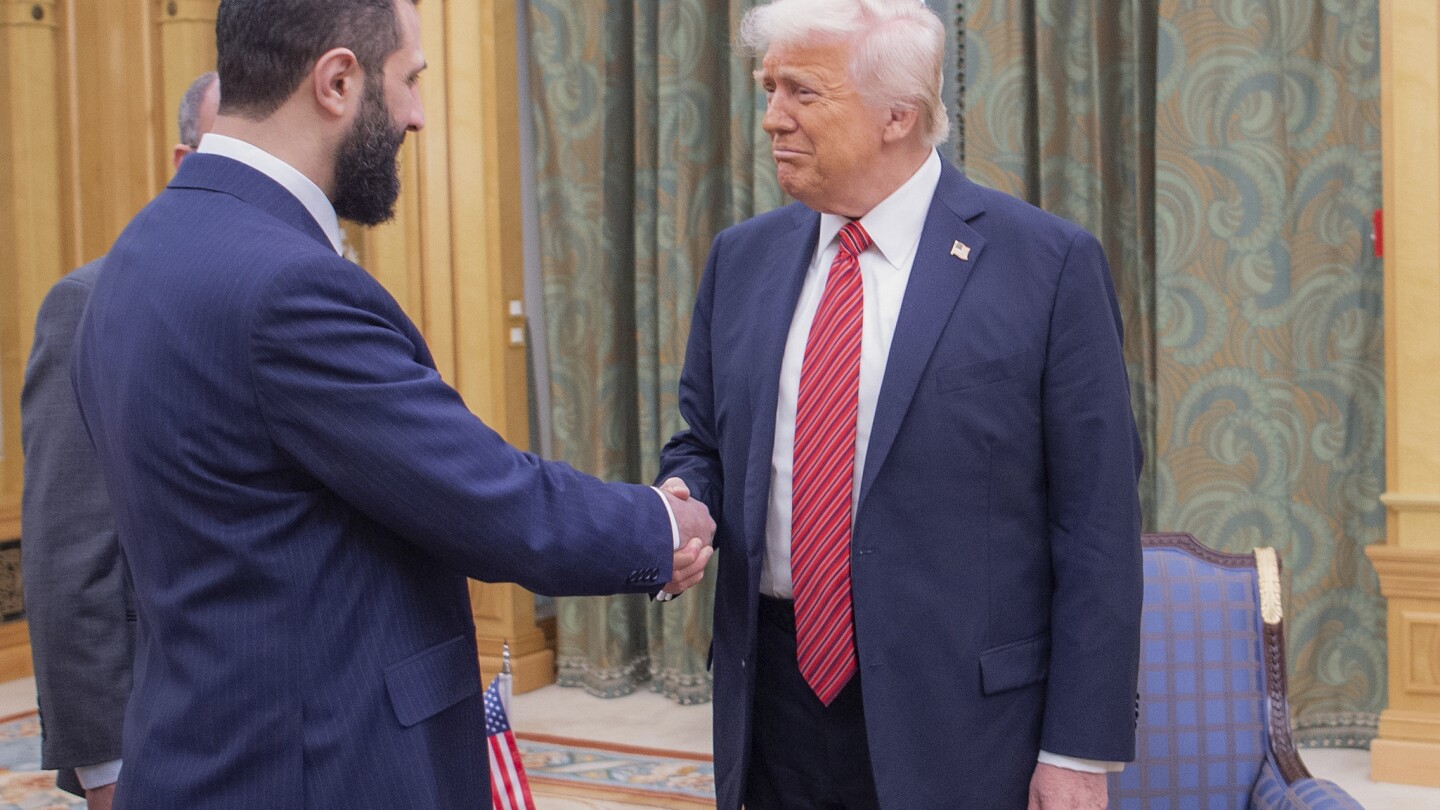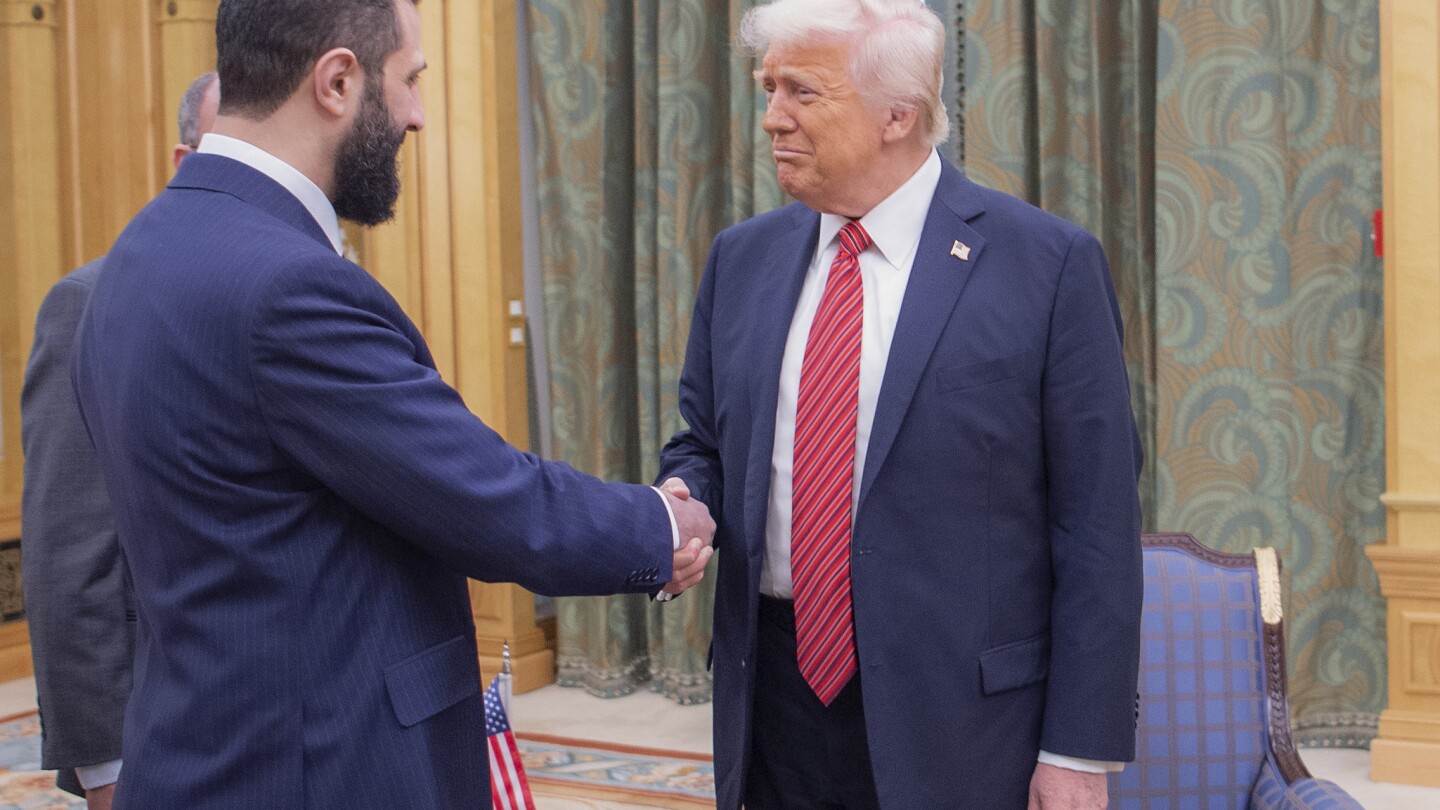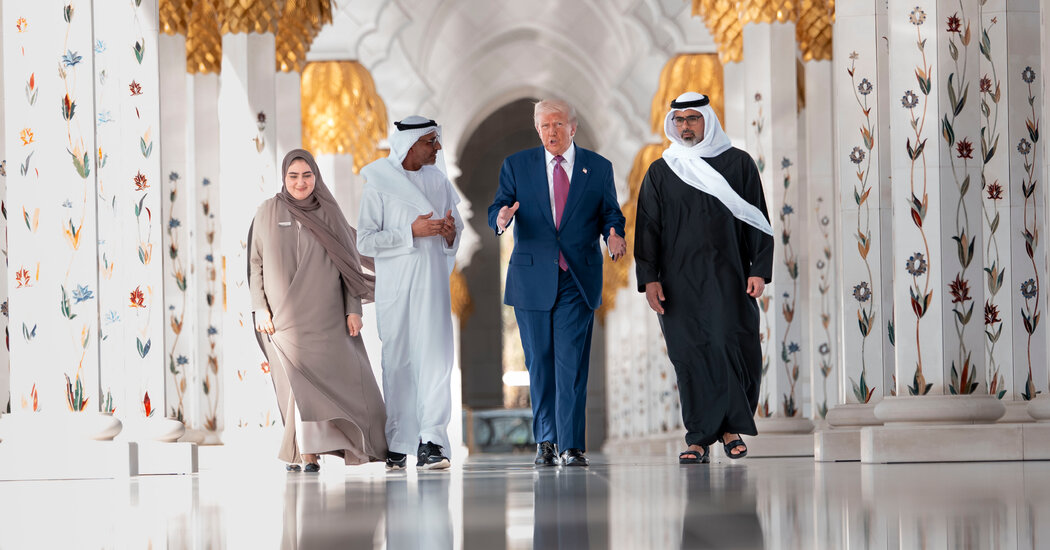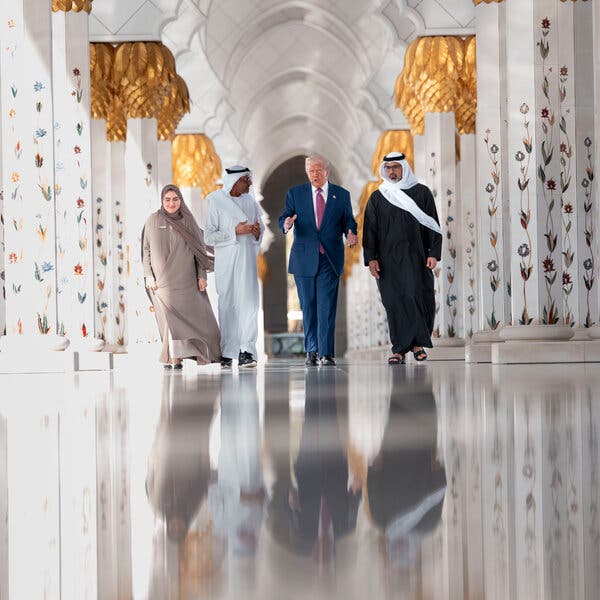## From Sands of Syria to Boardrooms of Dubai: Trump’s Middle East Gamble
Forget the Oval Office, imagine the White House as a sprawling wargame board. That’s the feeling you get with Trump’s Middle East tour, where real-world consequences are as heavy as the dice rolls. The New York Times paints a picture of a whirlwind trip dominated by Syria – a region hotter than a dragon’s breath – and deals inked in Dubai that smell suspiciously like a capitalist conquest.

Trump Wraps Up Middle East Visit Dominated by Syria and Business
Gamestanza Scenario: How Would Syrian Participation in the Abraham Accords Impact Regional Alliances and Peace Efforts?

The potential role of Syria in the Abraham Accords has significant implications for the region’s geopolitics. The accords, initiated by the Trump administration, aim to foster peace and cooperation between Israel and its Arab neighbors. If Syria were to join the accords, it would likely lead to a significant shift in regional alliances. For instance, the country’s participation could strengthen the bloc formed by Israel, the United Arab Emirates, and Bahrain, potentially creating a more robust counterbalance to Iran’s influence in the region.
Additionally, Syrian integration into the Abraham Accords could pave the way for a more comprehensive peace agreement, addressing the country’s decades-long conflict and potential for renewed violence. However, this would require addressing the Israeli government’s concerns about the lifting of sanctions on Syria, which could be a challenging hurdle to overcome.
From a Gamestanza perspective, the success of Syria’s participation in the Abraham Accords would depend on the country’s ability to meet the accords’ conditions, including diplomatic recognition of Israel and cooperation on counter-terrorism efforts. The Syrian government would need to demonstrate a commitment to reform and stability, which could be a difficult task given the country’s complex internal dynamics and external pressures.
The potential benefits of Syrian participation in the Abraham Accords are substantial, including increased economic cooperation, enhanced regional stability, and a reduced likelihood of renewed conflict. However, the challenges and risks involved should not be underestimated, and a careful assessment of the situation is necessary to determine the likelihood of success.
- Regional stability: Syrian participation in the Abraham Accords could lead to increased regional stability, as the country’s integration into the bloc formed by Israel, the UAE, and Bahrain would create a more robust counterbalance to Iran’s influence.
- Peace agreement: The accords could pave the way for a more comprehensive peace agreement, addressing the country’s decades-long conflict and potential for renewed violence.
- Economic cooperation: Syria’s participation in the Abraham Accords could lead to increased economic cooperation, including trade and investment opportunities with Israel and other regional partners.

Gamestanza Analysis: Will the Trump Administration’s Efforts to Broker Peace in the Region Succeed, or Will They Exacerbate Existing Tensions?
The Israeli Government’s Opposition to Lifting Sanctions on Syria Raises Concerns About the Potential for Renewed Conflict

The Israeli government’s opposition to lifting sanctions on Syria is a significant challenge to the Trump administration’s efforts to broker peace in the region. The sanctions, imposed under the deposed autocrat Bashar Assad, have had a devastating impact on the Syrian economy and population. Lifting the sanctions could lead to increased economic cooperation and stability, but it also risks emboldening hardline elements within the Syrian government and potentially leading to renewed conflict.
From a Gamestanza perspective, the success of the Trump administration’s efforts to broker peace in the region depends on the ability to address the concerns of all parties involved, including the Israeli government. The administration would need to find a way to balance the need for economic cooperation and stability with the need to address the concerns of hardline elements within the Syrian government and the Israeli government.
The potential consequences of the Trump administration’s efforts to broker peace in the region are significant, including increased regional stability, enhanced economic cooperation, and a reduced likelihood of renewed conflict. However, the challenges and risks involved should not be underestimated, and a careful assessment of the situation is necessary to determine the likelihood of success.
- Regional stability: The Trump administration’s efforts to broker peace in the region could lead to increased regional stability, as the lifting of sanctions and increased economic cooperation could reduce the likelihood of renewed conflict.
- Economic cooperation: The administration’s efforts could lead to increased economic cooperation, including trade and investment opportunities between Israel and Syria, as well as with other regional partners.
- Potential for renewed conflict: However, the lifting of sanctions and increased economic cooperation could also lead to renewed conflict, particularly if hardline elements within the Syrian government and the Israeli government are not addressed.

Gamestanza Perspective: What Are the Ethical Considerations Surrounding the US’s Approach to Syria, Particularly in Light of the Human Cost of the War?
The Humanitarian Factor: The Lifting of Sanctions Could Have Profound Implications for the Millions of Syrians Affected by the Ongoing Humanitarian Crisis

The humanitarian factor is a critical consideration in the US’s approach to Syria. The country’s ongoing humanitarian crisis, sparked by the civil war, has resulted in significant human suffering, displacement, and economic devastation. The lifting of sanctions could have profound implications for the millions of Syrians affected by the crisis, including increased access to humanitarian aid, improved economic opportunities, and enhanced stability.
From a Gamestanza perspective, the US’s approach to Syria must prioritize the humanitarian needs of the Syrian people. The lifting of sanctions should be accompanied by a comprehensive plan to address the humanitarian crisis, including increased access to humanitarian aid, support for internally displaced persons, and enhanced economic opportunities.
The potential consequences of the US’s approach to Syria are significant, including reduced human suffering, improved economic opportunities, and enhanced stability. However, the challenges and risks involved should not be underestimated, and a careful assessment of the situation is necessary to determine the likelihood of success.
- Reduced human suffering: The US’s approach to Syria could lead to reduced human suffering, as the lifting of sanctions and increased economic cooperation could improve access to humanitarian aid and enhance stability.
- Improved economic opportunities: The administration’s efforts could lead to improved economic opportunities, including increased trade and investment, which could help to alleviate the economic devastation caused by the civil war.
- Enhanced stability: The US’s approach to Syria could lead to enhanced stability, as the lifting of sanctions and increased economic cooperation could reduce the likelihood of renewed conflict.

Beyond Syria: Trump’s Wider Middle East Strategy
Shifting Focus: Trump’s Middle East Tour Emphasizes a Departure from Traditional US Foreign Policy, Prioritizing Economic Deals and Strategic Partnerships Over Nation-Building Initiatives
Trump’s Middle East tour emphasizes a departure from traditional US foreign policy, prioritizing economic deals and strategic partnerships over nation-building initiatives. This shift in strategy has significant implications for the region, including increased economic cooperation, enhanced regional stability, and a reduced likelihood of renewed conflict.
From a Gamestanza perspective, the success of Trump’s Middle East strategy depends on the ability to balance the need for economic cooperation and stability with the need to address the concerns of all parties involved, including the Israeli government and the Israeli people. The administration would need to find a way to prioritize economic deals and strategic partnerships while also addressing the humanitarian needs of the Syrian people and the need for nation-building initiatives.
The potential consequences of Trump’s Middle East strategy are significant, including increased economic cooperation, enhanced regional stability, and a reduced likelihood of renewed conflict. However, the challenges and risks involved should not be underestimated, and a careful assessment of the situation is necessary to determine the likelihood of success.
- Increased economic cooperation: Trump’s Middle East strategy could lead to increased economic cooperation, including trade and investment opportunities between the US and regional partners.
- Enhanced regional stability: The administration’s efforts could lead to enhanced regional stability, as the prioritization of economic deals and strategic partnerships could reduce the likelihood of renewed conflict.
- Potential for renewed conflict: However, the prioritization of economic deals and strategic partnerships could also lead to renewed conflict, particularly if the humanitarian needs of the Syrian people and the need for nation-building initiatives are not addressed.
Gamestanza Assessment: Can the US and Iran Reach a Mutually Acceptable Agreement on Nuclear Non-Proliferation?
The Iran Nuclear Deal: Trump’s Pursuit of a New Deal Signals a Potential Thaw in Relations, but Faces Significant Obstacles
The Iran nuclear deal is a critical component of the US’s approach to the Middle East, particularly in light of the country’s ongoing nuclear program. Trump’s pursuit of a new deal signals a potential thaw in relations, but faces significant obstacles, including Iran’s refusal to compromise on its nuclear program and the US’s insistence on stringent conditions.
From a Gamestanza perspective, the US and Iran must find a mutually acceptable agreement on nuclear non-proliferation. The administration would need to negotiate a deal that balances the need for stringent conditions with the need for Iran’s cooperation on its nuclear program. The deal would need to address the concerns of all parties involved, including the US, Iran, and regional partners.
The potential consequences of a mutually acceptable agreement on nuclear non-proliferation are significant, including reduced tensions between the US and Iran, enhanced regional stability, and a reduced likelihood of renewed conflict. However, the challenges and risks involved should not be underestimated, and a careful assessment of the situation is necessary to determine the likelihood of success.
- Reduced tensions: A mutually acceptable agreement on nuclear non-proliferation could lead to reduced tensions between the US and Iran, as the two countries would be able to cooperate on regional security issues.
- Enhanced regional stability: The agreement could lead to enhanced regional stability, as the US and Iran would be able to work together to address regional security concerns.
- Potential for renewed conflict: However, the agreement could also lead to renewed conflict, particularly if the deal does not address the concerns of all parties involved, including the Israeli government and the Israeli people.
Gamestanza Outlook: How Will the US’s Investment in AI in the Middle East Shape the Future of the Region’s Technological Landscape?
Tech and AI: Trump’s Focus on Technological Advancements Highlights the US’s Commitment to Maintaining Its Global Technological Edge
The US’s investment in AI in the Middle East is a critical component of the country’s approach to the region, particularly in light of the region’s rapidly evolving technological landscape. Trump’s focus on technological advancements highlights the US’s commitment to maintaining its global technological edge, but also raises concerns about the potential risks and challenges associated with the deployment of AI in the region.
From a Gamestanza perspective, the US’s investment in AI in the Middle East must prioritize the needs and concerns of regional partners, including the need for economic cooperation, enhanced regional stability, and a reduced likelihood of renewed conflict. The administration would need to develop a comprehensive strategy for the deployment of AI in the region, addressing the concerns of all parties involved, including regional partners and the Israeli people.
The potential consequences of the US’s investment in AI in the Middle East are significant, including increased economic cooperation, enhanced regional stability, and a reduced likelihood of renewed conflict. However, the challenges and risks involved should not be underestimated, and a careful assessment of the situation is necessary to determine the likelihood of success.
- Increased economic cooperation: The US’s investment in AI in the Middle East could lead to increased economic cooperation, including trade and investment opportunities between the US and regional partners.
- Enhanced regional stability: The administration’s efforts could lead to enhanced regional stability, as the deployment of AI in the region could address regional security concerns and reduce the likelihood of renewed conflict.
- Potential for renewed conflict: However, the deployment of AI in the region could also lead to renewed conflict, particularly if the US’s investment in AI is seen as a threat to regional partners or the Israeli government.
Conclusion
Trump’s whirlwind Middle Eastern tour has concluded, leaving behind a trail of both diplomatic tension and burgeoning business deals. While Syria’s brutal civil war and the potential for American military intervention loomed large, the president also forged key partnerships with Saudi Arabia and the UAE, focusing on economic and security cooperation. This balancing act, however, has sparked debate: some applaud Trump’s pragmatic approach to forging alliances and securing American interests, while others criticize his transactional diplomacy and potential to destabilize the region further.
The long-term consequences of Trump’s Middle East strategy remain unclear. Will the newfound economic partnerships withstand the pressure of geopolitical instability? Will America’s increased military presence in the region exacerbate existing conflicts or deter further aggression? Or will this be a pivotal moment, marking a shift in the delicate balance of power that has characterized the Middle East for decades? Only time will tell how these decisions will shape the future of the region and its fraught relationship with the United States.
One thing is certain: the Middle East is at a crossroads. Trump’s actions, driven by a potent mix of security concerns and economic opportunism, have injected a new level of uncertainty into an already volatile landscape. The world watches, holding its breath, as the dominoes begin to fall.